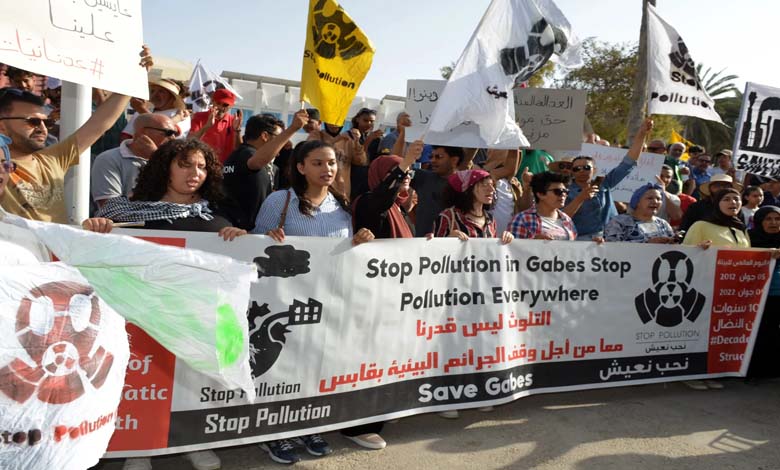Gabès suffocates… Toxic gas leaks trigger an environmental and health crisis in southern Tunisia

In the heart of southern Tunisia, the city of Gabès relives its tragedy with each new toxic gas leak from the chemical complex. Once an economic engine, the plant has now become a daily source of fear and anxiety.
-
Tunisia Denies Drone Strike on Freedom Flotilla Ship
-
Tunisia: Imprisonment of a former presidential candidate rekindles debate over the Brotherhood’s influence on the judiciary
The city lives in a state of constant alert: ambulance sirens, overcrowded emergency rooms, and parents watching their children struggle to breathe. This growing tension underscores the fragile balance between industrial development and public health protection, reigniting a long-standing question: how much longer must the residents of Gabès pay with their health for the chemical industry?
The recent cases of mass asphyxiation, which affected dozens of schoolchildren, are no longer isolated incidents but a serious alarm bell for the future of the city and its environment. With leaks persisting and no comprehensive rehabilitation or relocation plan in sight, civil society finds itself in open confrontation with the authorities, demanding urgent measures to stop the disaster before it becomes a nationwide health crisis.
-
The Tunisian Brotherhood… Exploiting crises to inflame the streets and attempt a political comeback
-
They Will Not Go Unpunished: The Accountability Process Tightens the Noose Around Tunisia’s Muslim Brotherhood
Popular anger
Gabès governorate is witnessing growing anger following a series of toxic gas leaks from the chemical complex that caused multiple cases of collective asphyxiation.
The most recent incident, in the Chott Essalem area, left more than 40 students suffering from suffocation and required their urgent hospitalization. While most have been discharged after treatment, more than ten remain under medical observation due to the severity of their symptoms.
-
Tunisia’s Muslim Brotherhood… Failed Attempts to Infiltrate Through the UGTT Crisis
-
The Ghannouchi Hunger Strike: A Desperate Attempt to Salvage What Remains of Tunisia’s Muslim Brotherhood
The local council described the incident as unprecedented in terms of its impact, warning that ongoing leaks could lead to far greater health disasters. Its demands include an immediate investigation, the shutdown of polluting units, and the implementation of a comprehensive maintenance or dismantling program for outdated facilities. The council also proposed a national strategy to gradually relocate industrial activity away from residential areas, while ensuring economic alternatives that preserve jobs and attract new investments.
-
Four Years After the Fall of Tunisia’s Muslim Brotherhood: An End Mandated by the People
-
On the Eve of the Verdict… Documents Reveal Tunisian Brotherhood’s Plot to Assassinate Kais Saied
Repeated incidents
The Chott Essalem accident is not an isolated case. The nearby town of Ghannouch has experienced similar episodes in recent weeks, including ten suffocation cases shortly after another incident that affected 25 people.
These recurring leaks have pushed residents to call for radical decisions, accusing the authorities of neglecting citizens’ lives. “Our lives have become unbearable,” says Sama Hammam, a mother of two. “We live in a nightmare. Our children suffocate before our eyes. What is happening is a crime against the city.”
-
Ghannouchi Continues to Hide Behind His Absence as Tunisian Judiciary Moves Forward
-
Tunisia’s Muslim Brotherhood and the Exploitation of the Palestinian Cause: A Fake Window for a Political Comeback
She added: “This is not polluted water that we can filter. We are talking about the air we breathe. Even if households had air purifiers – which is not the case – what about the streets and schools? When will the government put an end to this nightmare?”
An environmental hotspot
Civil society organizations have also raised their voices. The association Stop Pollution warned of escalating risks in the industrial zone due to outdated facilities and the absence of safety standards. It called for a serious investigation, accountability for those responsible, and the implementation of a 2017 government decision to dismantle polluting units.
-
Tunisia’s Muslim Brotherhood and the Poison of Discord in Gabès Protests They Once Ignored
-
The Travel to Conflict Zones Case: Has Tunisian Justice Honored the Blood of Its Youth?
The organization also warned that continuing with new chemical projects, such as ammonia and hydrogen plants in Gabès, would worsen the crisis instead of resolving it.
The Gabès crisis places the Tunisian government before a difficult equation. On one hand, the chemical complex is a vital economic pillar, providing around 57% of national phosphoric acid production, used in fertilizers, cleaning products, and soft drinks. On the other hand, the city has turned into a hotspot of environmental and health pollution, with thousands of lives at risk and rising rates of respiratory, cancerous, and skin diseases, according to local medical reports.
-
Libya Thwarts a Major Terrorist Plot near the Tunisian Border
-
The Tunisian Muslim Brotherhood and the Assassination of Belaïd… A Fragmented Narrative
Unbalanced development policies
Environmental expert Adel Ben Slimane explained that the main cause of the repeated mass asphyxiation incidents is the emission of hazardous industrial gases, particularly sulfur dioxide from phosphoric acid production units.
He stressed that these emissions directly affect the respiratory systems of residents living near the plants, which explains the recurring cases of suffocation, especially among children and the elderly.
-
Consecutive Security Successes: Tunisia Arrests 20 Terrorists since the Start of 2025
-
Tunisia in 2025… Year of « Security Vigilance » and Resolution against the Muslim Brotherhood
According to him, the situation reflects a deep structural failure in managing the chemical industry, with promised investments in gas treatment systems never materializing. Projects to improve ammonia gas treatment, which should have been completed over a decade ago, remain stalled, while efforts to reduce nitrogen oxide emissions, planned since 2015, are still on hold despite the installation of equipment.
Ben Slimane called for a gradual relocation of the complex away from residential neighborhoods, alongside urgent environmental projects to improve air quality. He concluded that Gabès, once a lush coastal oasis in the 1970s, has now become the victim of unbalanced development policies that threaten both public health and ecological sustainability.












